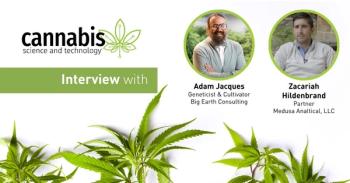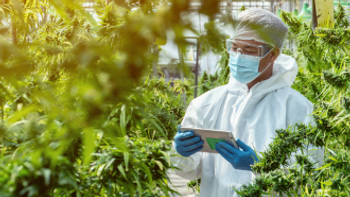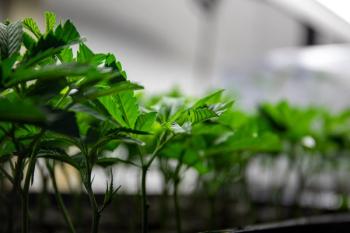
Cannabis Science and Technology
- January/February 2020
- Volume 3
- Issue 1
Debugging the System: Understanding Pests, Pest Control, and Pesticides

Some of the most common pesticides monitored within the cannabis industry are examined here and the function and chemistry of these agents in cannabis pest control is broken down.
The reduction of crop loss from pest damage is often one of the most important goals in agriculture. The cannabis industry is now being called to task to account for the use of modern pesticides in their efforts. But, pest control in our modern times is a complex set of management strategies that include a variety of different tools in the arsenal. In this column, we examine the history of pest control and the strategies of modern pest management, including pesticides. By understanding the different approaches of pest management, the chemistry of pesticides, and life cycles of pests the cannabis industry can create better strategies not only to protect their products but also increase their output through better pest control systems. We examine some of the most common pesticides monitored within the cannabis industry and break down the function and chemistry of these agents in cannabis pest control.
Pest control is often considered to be a modern invention born of the chemical revolution at the turn of the last century. It is true that chemical pest controls are a relatively recent invention, but the practice of pest management is the product of evolution and biological relationships. The first acts of pest control were simple techniques such as fire to ward off dangerous predators or mud to cover the skin from biting insects. As agriculture came into existence, techniques increased from personal protection to include protection and expansion of crops. At its heart, the need to control pests is an expression of the control of species relationships.
Biology of Species Interactions
All the variations of interactions of species can be simplified into three basic scenarios. The first is mutualism in which the organisms involved actions benefit one another. An example in nature is the codependence of plants on nitrogen fixing bacteria in their roots. Each organism gains from the interaction. A human example could be some agricultural interactions such as with fruit trees where the humans gain food and the plant is cared for and seeds are spread.
The second type of interaction is commensalism. Commensalism is species interactions in which one species benefits and the other species neither is benefited nor harmed. Examples of these interactions include the relationship of epiphytes such as orchids which grow on trees. The trees do not benefit from the orchid but are not harmed.
The third basic type of interaction is one of the most complex interactions-parasitism or predation. In these interactions, one species benefits but the other species is either harmed or killed. It is these interactions that started the need for pest management.
History of Pest Management
Prior to the industrial and chemical revolution of the 19th and 20th centuries there was a slow and ongoing battle with simple tools and chemicals. The early chemical weapons were elemental compounds of sulfur, heavy metals, and salts. Some of these compounds were in use up through the present day. Elemental sulfur was one of the earliest known pesticides used to deter lice and other pests. Heavy metal compounds were popular because of their toxicity. Arsenic compounds were highly effective against insects, bacteria, and fungi by binding with biologically important thiols and interrupting enzymatic processes, such as adenosine triphosphate (ATP) production. Mercury compounds also have an affinity for thiols and disrupt biological processes. Lead compounds act as a calcium analog and block calcium driven processes in the organism, such as heme synthesis. These inorganic compounds lasted a long time and were not easily degraded. Unfortunately, they often leached into the ecosystem, wreaking havoc on local wildlife and posing a health threat to its human inhabitants.
Over the centuries science moved from religion and magic to practical study. The disciplines of chemistry and biology were founded, opening up studies into chemical compounds, reactions, and chemical synthesis. Pest control methods grew and benefited from this pursuit of knowledge. The 19th century saw the start of chemical synthesis and the rise of chemical pesticides. At first, chemicals were extracted and purified from their botanical sources. It was at this time that nicotine compounds were purified from tobacco, pyrethrums were extracted from flowers, and rotenone was isolated from roots. Compounds were blended and produced for the purpose of pest control. In 1814, an inorganic compound of copper (II) acetoarsenite called “Paris Green” was introduced as a pigment. By 1867, Paris Green was widely sold as an insecticide and rodenticide, which was produced up until the 1960s.
During the Victoria era, traditional pest controls were investigated and their chemicals identified and isolated. As a result, all of the chemical compounds that were historically available in their botanical forms (for example, rotenone in roots and pyrethrums in chrysanthemums) were purified for commercial and home use, and elemental compounds were blended to create more efficient pesticides. The humble beginnings of simple, natural repellents and physical pest controls grew into chemical and agricultural industries seeking out new and improved methods.
Modern Pest Management
Modern pest management and control is an increasingly diverse science with thousands of different management strategies. More recently, pest control efforts have evolved into management strategies. The management strategies are developed around three goals: repel pests or prevent predation; control the life cycle of the pest and stop damage or predation; and eliminate or kill the pest. These three goals depend upon three basic types of pest control groups: physical controls, biological controls, and chemical controls. Physical control mechanisms are strategies that include nets, fences, smoke, and fire which create barriers to limit contact between predator and prey. Biological controls use other organisms to control target pests by exploiting other natural predator-prey relationships. Examples of this type of control are very diverse from companion planting to use of predator insects such as lady bugs or praying mantis in gardens. The ways biological controls are implemented can be by importing native or nonnative predators to an area that is without a predator, or by augmenting the native predator concentration. A final method of implementing biological control is conservation or increasing of predator habit or conditions to increase predator growth.
The most popular strategy of modern pest control is chemical controls. Chemical controls are poisonous substances that control organisms that are harmful to human or animal health (biocides and pesticides). Pesticides are substances intended to prevent, destroy, repel, or mitigate any pest. They also are plant regulators, defoliants, or desiccants. The classes of pesticides include all the target groups of biota from bacteria (bactericides) to large predators (predacides). In agriculture, we are most familiar with insecticides, fungicides, and herbicides with herbicides being the most widely used type of pesticide (1).
All pesticides are either broad spectrum (nonselective) or narrow spectrum (selective) in their target species. Broad spectrum pesticides kill or incapacitate a wide variety of species, which was common among many early pesticides such as heavy metals and DDT. Narrow spectrum pesticides target specific groups of organisms, such as an antimicrobial agent.
Pesticide Application and Mode of Action
Most pesticide compounds are not applied as pure materials, but are often combined to facilitate application, delivery, and efficiency of the pesticide. Pesticide formulations often include more than just the active ingredients. Additional chemicals such as solvents or substrates are added to aid in the final form of the applied pesticide (liquid, solid, gas, or aerosol) or in application (dispersants, carriers, and stabilizers). The active ingredients are the either natural or synthetic substances that will kill or disable the targeted pest.
Pesticides can be applied to maximize the vulnerable life cycle stages of pests. Efficient pest management strategies depend on several factors including the life cycle of pests, timing of pesticide application, selection of strategy to accomplish the goal (regulate, control, or destroy), and the mode of action of the pesticide. Some agents are applied as protectants prior to the planting or laying of eggs or seeds. Agents can be applied prior to emergence of the pest from the egg, seed, or larval state. Finally, agents can be applied to eradicate pests after emergence. Pesticides are delivered to the pest organism by inhalation, ingestion, or absorption.
Modes of action in pesticides define the systems, processes, or organs which are targeted by the pesticide. Biological systems such as growth, respiratory, circulation, or digestive systems are the target of some pesticides. Other agents target specific biological pathways or processes to stop, limit, or control those processes such as reproduction. Finally, there are agents that target specific cellular locations to control or limit cellular functions such as controlling ATP production or blocking neurotransmitters. The most common modes of action are: agonists (activators) which bind to a receptor to illicit a response or antagonists (disruptors, inhibitors, or blockers) which bind to a receptor to stop a response or modulators which control reaction rates (Figure 1). The ways in which these actions are accomplished are most often by either mimicking natural process chemicals or by creating barriers that block channels and processes.
The modes of action of pesticides are a key component to a management program, which maximizes performance and efficacy of selected pesticides and reduces the possibility of pesticide resistance. Resistance occurs when the targeted pest is no longer controlled by the pesticide because of repeated exposure. Management strategies try to minimize resistance to any one agent by changing agents or targets throughout the season. The Insecticide Resistance Action Committee (IRAC) grouped pesticides according to target process and mode of action. The targets include nervous and muscular system pesticides, growth inhibitors, respiratory pesticides, midgut pesticides, and nonspecified action (Table I).
The development of a pest management strategy involving pesticides must also consider the chemical and environmental concerns of the agents being applied and how those agents will react with each other and the environment. Chemical compatibility is when two or more chemicals can combine safely. The combination could produce a synergistic action in which each chemical is aided by the addition of the other or an additive effect where the potency or action is increased by the combination of agents. There is also an opposite or antagonistic chemical incompatibility. These incompatibilities can be issues of physical insolubility, chemical precipitation, or unintentional toxicity. Potentiation occurs when the combination of two or more compounds becomes more toxic than the individual components. This effect is usually not intended by the formulator. Therefore, it is important to understand the chemical nature of the pesticides being used to determine if they can be combined safely in a way that does not work to the detriment of the goal of pest control.
The Common Cannabis Pests
Just like any other agricultural crop, cannabis is subject to a wide variety of pests from the smallest viruses (Tobacco Mosaic Virus) to animals such as birds, rodents, and burrowing animals. But, some of the most destructive and common pests for cannabis are insects and fungi (Table II).
Some of these common parasites and pests can be effectively treated by combinations of pesticides with different modes of action (where permitted by state regulation and registry) (see Table III). The most applicable against a variety of common cannabis pests are the broad spectrum nervous system disruptors (Groups 1, 2, 3, and so on), which include organochlorine pesticides, pyrethrins, and neonicotinoid pesticides.
Since cannabis continues to be a contentious agricultural product under legal debate and U.S. federal restriction, the selection or registration of pesticides for cannabis crops is still up to discussion and debate. It has only been within the past few months that the U.S. Environmental Protection Agency (EPA) has opened discussion of the issuance of pesticide registrations for hemp products. The state of Colorado is one of the more active agencies working to find applicable pesticides for hemp and cannabis use with the majority of their approved agents being Azadirachtin (Neem Oil), pyrethrins, and mixtures of botanical and mineral oils. Azadireachtin is a terpenoid from the neem plant that acts as a feeding and growth restrictor in insects. By an action of being an ecdysteroid hormone disruptor, the compound stops insect molting and development stages and arrests or slows growth and reproduction (3). Pyrethrins are nervous system disruptors that are sodium channel modulators, which interrupt the normal flow of sodium ions in and out of the neuromuscular cells and then cause muscle twitching, spasms, and death (4).
Pyrethrums were one of the earliest biological pesticides originally sourced from Chrysanthemum cinerariifolium and Chrysanthemum coccineum flowers. Pyrethrins were some of the earliest isolated chemical pesticides and helped move pest control from natural sources to chemically manufactured materials. The difficulty, cost, and availability of isolating natural sources of pyrethrins pushed the creation of synthetic pesticides, which are in common use today.
Final Thoughts
Since the start of the production boom in the 1940s to present day, a huge catalog of thousands of insecticides, herbicides, and general pesticides was developed, including organochlorides (DDT, BHC), organophosphates (parathion, malathion, azinophos methyl), carbamates (aldicarb and carbofuran), and neonicotinoids (imidacloprid and acetamiprid). As modern pesticides develop, there has been a shift to understand and apply the chemical properties and interactions of pesticides with both the environment and animals other than the target pests. Early pesticides were for the most part persistent chemicals that affected the nervous system of invertebrates. These pesticides had in many cases limited solubility and persisted for years or decades after delivery. More modern pesticides take into consideration environmental impact and a larger pest management strategy.
Chemical pesticides are now an integral part of the world’s agricultural arsenal, offering protection to crops from destructive pests. However, some disastrous side effects of their use include probable leaching of these chemicals into the environment and their ultimate presence in the human food chain. Because of this, pesticide residue analysis has become a serious testing process for several laboratories, most lately cannabis. Each pesticide group in historical or modern use has their own set of physical and chemical properties that can make pesticide analysis a challenge. If the complexity of cannabis products are added into the analysis it can further complicate an already extensive analysis. The lack of clear regulations, documentations, and methods has over the past decade become a hurdle to effective pesticide residue testing. Fortunately, as the next decade arrives more governments and organizations will become involved in the regulatory and testing processes to help the cannabis industry develop their own pest management strategies that are effective, safe, and sustainable into the future.
References
- 1. JUS EPA, OCSPP. 2015. “Pesticides Industry Sales and Usage 2008 - 2012 Market Estimates.” Reports and Assessments. US EPA. October 29, 2015.
https://www.epa.gov/pesticides/pesticides-industry-sales-and-usage-2008-2012-market-estimates. - (“Modes of Action (MoA) Classification.” n.d. IRAC. Accessed December 10, 2019.
https://www.irac-online.org/modes-of-action/ . - (Koul, Opender. 1996. “MODE OF ACTION OF AZADIRACHTIN.” In , 160–70.
- (Narahashi, T. 1971. “Mode of Action of Pyrethroids.” Bulletin of the World Health Organization 44 (1-2–3): 337–45.
About the Columnist
Patricia Atkins is a Senior Applications Scientist with SPEX CertiPrep and a member of both the AOAC and ASTM committees for cannabis.
How to Cite This Article
P. Atkins, Cannabis Science and Technology3(1), 18-25 (2020).
Articles in this issue
almost 6 years ago
Vapes: What Are You Actually Inhaling?almost 6 years ago
Dispelling Cannabis Analysis Calibration Mythsalmost 6 years ago
Five Steps to Prepare Cannabis Testing Laboratories for ISO 17025 Auditsalmost 6 years ago
Ask the Experts: Cultivationalmost 6 years ago
New Year, New CannabinoidsNewsletter
Unlock the latest breakthroughs in cannabis science—subscribe now to get expert insights, research, and industry updates delivered to your inbox.



